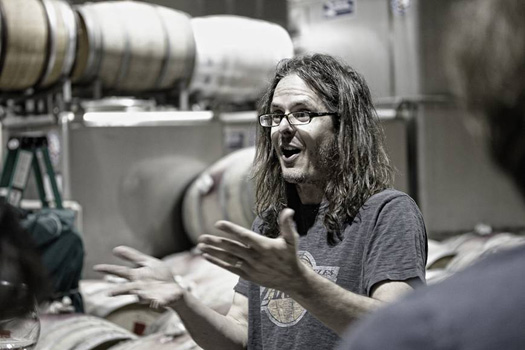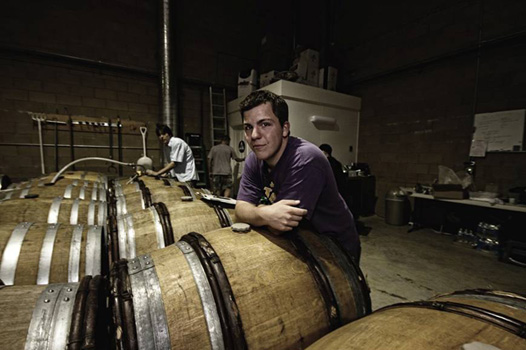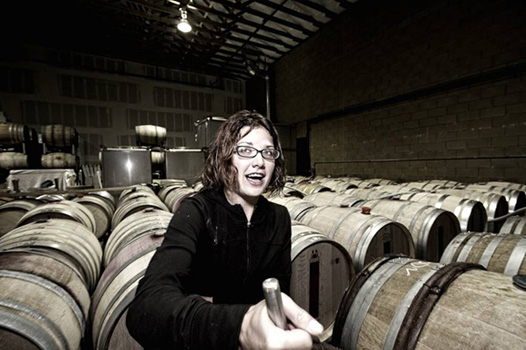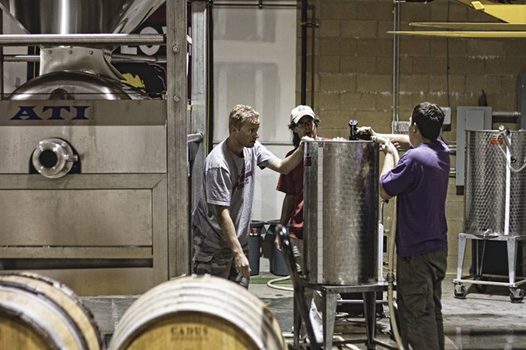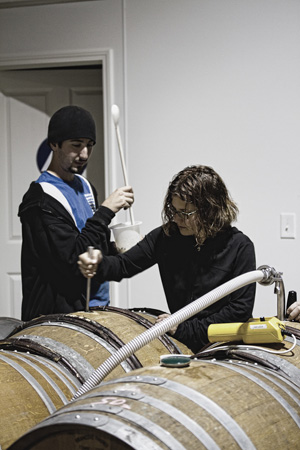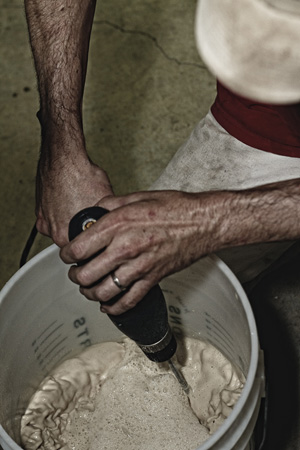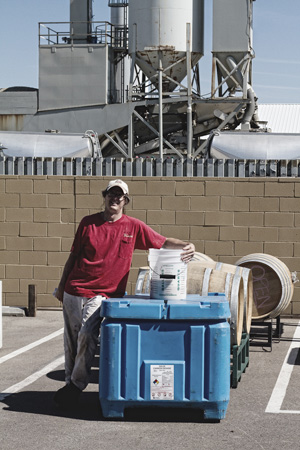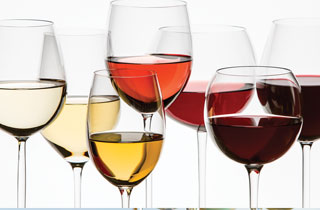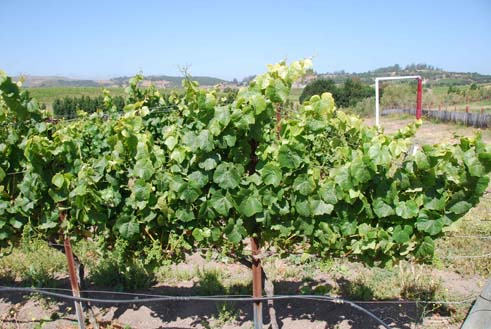(Another) Year in the Vineyard, Week #30
The Beginning of the End, and One Hell of a Scare
(all photos this week courtesy of www.bottlebranding.com and Jeremy Ball..thanks Jerms!
Mouse over photos for captions..and a secret code that proves Elvis is still alive!)
Today is a good day. A really, really good day. I haven’t felt so relaxed in months. After finishing the longest day of the vintage yesterday I knew that we wouldn’t have to wake up for a 3 am pick this morning, so I initially reserved the right to go out with the crew for a few drinks last night—stay up late and be crazy—like at least 10:00 pm!
But (lo and behold), come 7:18 pm I was man down in our bed, which is a bit later than I have been going to sleep, but not exactly a bedtime that denotes an iron man party-when-I-can mentality. And I’m OK with that. I didn’t wake up until after 7 am and those 12 hours of pure and unadulterated sleep were a revelation.
Tomorrow is the last pick at Clos Pepe for the whole year—two acres of pinot noir for Brian Loring at the Loring Wine Company. We’ll start at 3 am, finish around 8 am, and then head to the winery, get our work done there, and then come back to the vineyard to prepare for our big vineyard feast for our pickers and workers. We do this once a year to make sure those that do the hard field labor and picking for us (even though we pick with them every day) feel that they are appreciated and celebrated. So we have 6 lb. of Chicharrones and 5 lb. of fresh tortilla chips, and a gallon of smoking-hot salsa ready to go, as well as enough sodas and beer to fill a bathtub. Mikey’s taco truck (of legend) is scheduled to be here at 11:30 to start firing up the Mar y Tiera tacos—perhaps the best tacos I’ve ever had. Exciting stuff! Mikey’s truck is not exactly state of the art (it might have been in 1965), and last year he was late because he got a ticket for driving the truck’s maximum 35 mph between Lompoc and Clos Pepe. We hope he’s upgraded the two hamster wheels that apparently propel the taco truck. But do not second guess the quality that comes out of the sad, sad white truck. The carne asada mixed with grilled shrimp tacos are the gourmet surf and turf of Mecki-food. Yum, yum, yum. I’m salivating just thinking of them.
This week was a hell of a thing. Six night picking out of seven, m ostly starting at 3 am, but we did experiment with a midnight pick. Of course the midnight pick had to fall on a day where the vineyard chiulled down into the high 30’s, and it’s rather hard to pick or sort when you can’t feel your fingers. I hope our producers appreciate cool, perfect fruit ready to pick up at the crack of dawn, because we worked tirelessly over the last 20 days to get the entire vineyard picked and picked clean. That would have been enough work to keep me busy, but besides wearing my vineyard manager hat, I am also a winemaker for our Estate wines and Axis Mundi label, so after the 3 am picks, we headed off to the winery to complete a 1000 case production of Clos Pepe Estate pinot noir and chardonnay. Picking and crushing/destemming pinot noir is a good night/day’s work, and sometimes got us into the 11-12 hour days, but yesterday we picked almost 5 tons of Chardonnay, and our awesome, but small, press had to be filled, pressed and emptied 4 separate times—a longer day than we’ve had all year.
We started at 3 am, began pressing (Adrien and I) at 4:08 am, and unloaded the dry skins of the last press at about 2 pm. Then, after a few hours of additions, yeast swelling, inoculation, punch downs and a LOT of cleaning and dishes, we had processed the last Estate juice/grapes that is coming in this vintage. We still need to do punch downs, pressing, testing, organizing, racking, etc., but the fruit’s all in and that means I can take a deep breath and realize that weather no longer has the ability to confound and frustrate our grapes or our wine. And of course now the weather is forecast to be cool and sunny (perfect) for the next few weeks, which makes sense. Why would the nice weather occur during harvest and winemaking? So I’ll have to exploit the fine, fine weather outside by working the interns a little harder, grabbing Jeremy and hitting La Purisima Golf Course. I already have a tee time with my two favorite chefs and Jeremy next Tuesday morning. (Pictures/video for next week’s blog?)
Which reminds me: next week will be the last weekly Blog for the Year in the Vineyard, Volume 2. I’ll wrap up the year with some summaries of what we did, what we picked, yields, how much wine we made, and how we tie up the year in the vineyard and the winery. And then we’ll put the vineyard to sleep, finish our last bits of winemaking, drop Adrien at LAX for his trip home to Chablis, France, and I’ll start working on the Ballard Canyon AVA Petition project in earnest again.
But I promised you a good story and I will not disappoint. Whether my sleep deprivation finally manifested in a brain-meltdown or it was an honest mistake, I can’t tell, but yesterday I was stretched to the point of madness during our last push on Chardonnay production. On Sunday I went through the lower Wente Chardonnay field, an area that you may remember was frosted in April, and made a pretty good recovery a few weeks later. We tried a double-pruning technique, repruning the vines after frost, and we got almost twice the recovery we expected—a bit over 2 tons per acre! The quick and dirty test I did in the Lower Wente Chardonnay (a clone named for the Wente family in Livermore who produced this fabulous cultivar of Chardonnay) showed 23.8 degrees Brix…just about perfect for the style of Chardonnay I like to produce (steely, elegant, minerally, can go 10 years in the cellar). So we scheduled a Wednesday pick date—which I thought would guarantee the Chardonnay would be plenty ripe to pick.
So we got the first ton of Chardonnay out in short order—in about 30 minutes (the clusters are much larger than pinot noir and buckets fill fast), and Adrien and I raced the fruit over to the Lompoc winery and had the press loaded by 4 am. One thing (of many) I’ve learned from Adrien (who seriously has Chardonnay running in his veins), is to taste fruit on the bin while sorting. Bad for the enamel…GOOD for the wine. We put about 30-40 lb of fruit in our mouth every hour..tasting, discussing, sorting, spitting skins and seeds on the vineyard floor. So we tasted and tasted and kicked any green fruit out of the Wente pick, trained our replacements for exactly what we wanted as the pick continued while we were at the winery, and soon enough we were watching a cascade of amber sweetness dripping from the press into the pan, and being pumped gently away into a 2000 gallon tank. But as the pan was still full I grabbed 500ml of juice, tasted it (yum) and ran it over to the lab table to see what we were dealing with. I was ready to see slightly lower Brix levels on the lowest elevation of the pick, and expected the subsequent bins to be a little higher as they were less affected by the frost. But as I bobbed my trusty hydrometer (looks like a long thermometer that measures how much sugar is in a liquid by measuring how heavy the fluid is) that I’d been using all season long, it tragically floated very low in the juice and read only 20.5 degrees Brix. Now 20.5 degrees is perfect for sparkling wine, but it’s lean even in my craziest moments for still wine. The pH was much more reasonable—perfect even, at 3.18. I tasted the juice again—it sure tasted perfect, and the strong acidity was exacerbated by the hypersensitivity brought on my tasting fruit all morning. So I believed my lab result and tried not to panic. The next lot would be riper, and by the time we filled the tank with about 750 gallons of juice everything would be blended, perfect and right in the world. But it wasn’t. Next lot pressed out at 21 brix, then the third press load (that I expected to be at least 25 degrees Brix, was 20. When the last load tested just under 20 I was basically in a panic. Hadn’t I done my due diligence? Was my field test completely wrong and faulty? After 14 years of managing vineyards, tasting juice, judging wine professionally, could I really have been *this* wrong?
We blended all the lots into a single tank (after committing to making the wine and not selling some of it off for sparkling production), and I bled a blended sample into a beaker. Poured the juice from the beaker into a graduated cylinder, took my hydrometer and a deep breath and floated it. The reading came back as the hydrometer sunk almost all the way to the tip of the cylinder: 17.5 degrees Brix. Now this was the moment..with all those hot days, with all the elevated ripeness we’ve been seeing, how in the world could Chardonnay at Clos Pepe be 17.5 degrees Brix in mid October? Panic bled into disbelief…it couldn’t be correct—it just couldn’t be. At 17.5 degrees Brix the juice tastes as tart as unripe lime juice. This juice tasted delicious, rich, even somewhat tropical, like an apple pie with a side of mango coming out of the press. And a 7th generation Chablisienne was perfectly comfortable with the crop we brought in. For the first moment, I allowed myself to doubt my instruments—a hydrometer that had been giving me very trustworthy numbers all harvest long. It had been a trustworthy workhorse…and that, in the end, was what had fouled the gears in the lab.
Well, you saw at the beginning fo the blog that I am in a really, really good mood today, so you have likely guessed that everything worked out in the winery yesterday. Because if I had 17.5 degrees brix juice (750 gallons worth), that would have likely made the 2010 Chardonnay for the Estate program really, really hard to pull off. So I pulled the hydrometer (old ‘trusty’) out of the juice and inspected it critically. It was then that I noticed a hairline fracture on the skinny part with numbers and marks on it (very hard to see) and that there was a small, but visible amount of water or juice near the weight portion of the base. Oh, thank the gawds! I went to my lab closet and retrieved two other, new, backup hydrometers and refloated last year’s Old Trusty into the same tank blend of Chardonnay juice. The angels began to sing, the skies opened up, coyotes started asking our sheep out to prom. Twenty-three point freaking 8. The hydrometer was broken the whole time! I could have trusted my gut that all was well. I summoned the interns and told them the good news, I called Chanda and told her ‘a funny story’.
We filled the barrels three quarters full to start fermenting them, and by 4 pm the winery was clean and a very long day had completed in the best way imaginable. The Estate Chardonnay will be perfect this year. Nothing to add, nothing to fix. The way it’s meant to be.
Please take a moment to see me hurling the faulty (French) hydrometer against a brick wall: http://www.facebook.com/wes.hagen#!/video/video.php?v=444105557571
